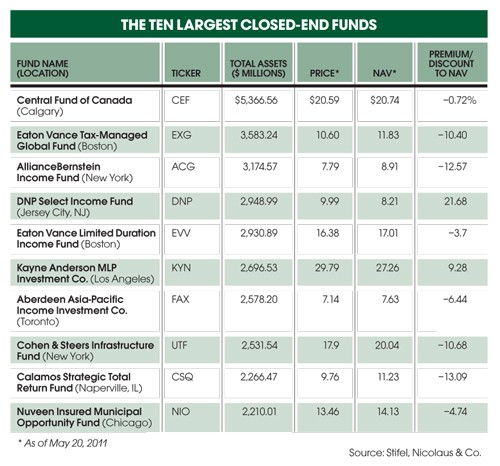ClosedEnd Fund
Post on: 24 Апрель, 2015 No Comment

Closed-End Fund
In the US, closed-end companies are one of four types of investment companies along with mutual funds. exchange traded funds and unit investment trusts. [1] It is a fund that issues a fixed number of shares, and issues new shares through Rights offerings. The value of the shares in a closed end fund is determined by the market value of their shares on the exchange.
The closed end fund, uses a professional manager to invest the fund’s assets in a diversified selection of securities. It has a fixed number of shares. Shares are traded between market participants. Thus, shares of a CEF can trade at a premium or discount to the perceived net assets value of the portfolio. This price elasticity is based upon demand for the CEF’s shares, rather than the value of its assets. [2]
Most closed-end companies are designed for capital appreciation. Many investors buy stocks because, historically, as a group they have shown the highest returns. [3] Many of the CEFs are designed for distribution yield. Almost all closed-end companies distribute interest. dividends. and capital appreciation. annually. Managed income CEF’s may pay out part of the principal to meet there goals.
The history of closed-end funds began more than 30 years before the first mutual fund was formed in the United States. [4] Because management is not influenced by the demand for shares of its fund like open-ended funds. CEF’s have a real advantage in illiquid markets, or when making direct placements.
The Investors total return is a combination of the change in its actual market price over the periods measured, plus the effect of fund distributions, whether reinvested or paid in cash. [5]
CEF’s have been an important investment tool since 1896, their use today is quite a bit different than of the previous generation. Mainly people buy them to make more money.
Investors will want to read the prospectus for any offering. These are available online. Yield has to analyze. How is it composed? Is it equalized over the year’? Is it partially a result of leverage? How much gearing is allowed and used within the CEF? What is the amount of UNII: undistributed net investment income? This is income earned but yet to be paid out. It can result from carry trade, roll ups, reverse repos or interest rate swaps; in other words, from leverage.
These investments are not as plain vanilla as they used to be. They deserve a place in the retirement income portfolio, perhaps 5 — 10% — as they do give off go yield, but be aware. Their risks can be hidden from the unwary. If you are uncomfortable with investigating securities, avoid these.
Good resources for these are: NYSE.com, NASDAQ.com, the CEFA website and quantumonline.com.
ETF’s are not closed-end companies. A new entry to the CEF field is from Powershares. This ETF has the ticker PCEF. PCEF is open-ended, not a closed-end company. It has all the disadvantages of an open-end fund. It is based upon the S Network Composite Closed-End Fund Index. This index currently holds 76 of the 624 CEFs trading, focusing upon taxable income, high yield emerging debt and option-income funds. The expense is .50%, but the total expense is closer to 2% if one factors in the expenses of each underlying fund. The current distribution yield is 6.7% and the ETF trades at a small discount (2.6%).
The benefit to owning this ETF is the diversification, intraday liquidity and distribution yield, all of which closed-end companies also have. It is an easy way to own the market sectors and enhances the return potential — as well as the loss potential.
As of this writing (today) the Index has added sixteen new CEFs and deleted four from its membership. Current news on this Wikinvest page shows these changes.














